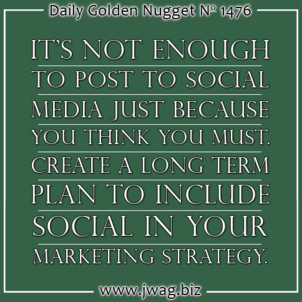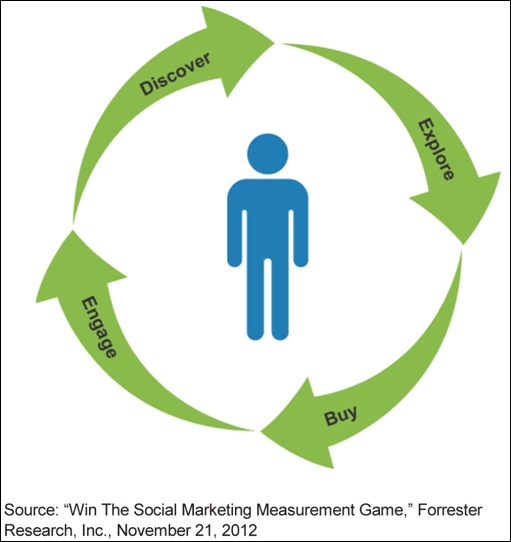
Social media is required for business--all businesses. It ties all your other advertising together: every ad you place in your local community, whether it's on TV, radio, on billboards, in all of your direct mail, for newspaper ads, or everything else you do on other social networks. Social media ties all your marketing together in such a way to support your customer life cycle.
Customer Life Cycle
There are specific steps that every customer must travel through before deciding to purchase from you. We can illustrate that cycle in 4 simple steps of initial discovery, exploring and self education, buying, and then engaging with you after the sale as illustrated here:

The discovery and exploring happen online through web search and social media. The buying can take place either online or in person, but then the engagement part of that life cycle usually return to social media and becomes part of the initial inspiration and discovery process for your next customer.
That initial inspiration is now referred to as the Zero Moment of Truth, or ZMOT for short. That when we get the first idea to look for a product or a service, usually triggered by a personal need, a conversation with someone, or simply seeing something online in our social media feed.
The 1989 movie Field of Dreams popularized the motto "If You Build It, They [he] Will Come," which seemed to be the creed that many dotcom websites of the late 1990s were living by. Most business owners think that the "build it" refers to just opening a business and waiting for the flood of people to come rushing in. If that motto were true, none of us would have to be involved in the customer life cycle other than the "buy" step shown above.
In the internet age, we need to build and nurture all aspects of it, before and after the sale. Customers won't come walking through your door any more until they fully learn about your product or service. They won't waste time with an in-person meeting until they are sure they should bother meeting you in the first place. Those four life cycle steps can be broken out into much smaller pieces...
Internet Life Cycle Steps
To help you fully understand what's involved with the customer life cycle, I've broken it up into 14 specific steps as follows.
Step 1: ZMOT
The Zero Moment of Truth is when someone first gets the idea that they might be interested in your product or service. Anything could trigger this, including a conversation with a friend, watching a TV show, listening to a radio, or seeing something posted socially by one of their friends.
Step 2: Initial Search
The ZMOT immediately turns into a search on Google or Bing. Your website will only appear in the results if you've built up your online identity to match the search query they are looking for. That means building online content to match all the possible products and services you offer. The content you are building should be in the form of a blog, or galleries of photos that can be shared socially.
Step 3: Google+ Discovery Through Search
While you might not deem Google+ as an important social network to participate on, Google certainly does. All that content you build to match products and services should be shared to Google+ as a quick way to help it get found in Step 2 above. What you share to Google+ oftentimes appears in Google SERP more highly ranked than the same information on your website.
Step 4: Found On Social
Depending on their individual preferences, some people will search Pinterest and Google Images for product information instead of the regular Google Web Search. The photos you create should be named correctly for optimal Google Image Search usage and also pinned into your Pinterest account. Make sure to include a link back to your website from each pinned image on Pinterest.
Step 5: Reading Your Blog
As mentioned in Step 2, you could be writing blog posts as a way to capture attention during the initial search. By the time they get to this step, they have moved from the discovery stage to the explore stage of the life cycle. Customers educate themselves more deeply as they read your blog, and any other educational information you have on a topic or product. This is also where very detailed product catalog information comes into play, because the customer's knowledge increases as you include more details online. The more details you provide online, the greater trust you will gain.
Step 6: Read About You
Once you've gained their trust with an overabundance of information, they will then investigate you a little further by reading your about or company history page on your website. They will also investigate the other services you provide. This is the stage in the life cycle where they will determine if you are worthy of their purchase at some future point.
Step 7: Facebook
Assuming you have a link to your Facebook account on your website, they will probably jump there after reading your website. The people who decide to like your Facebook page are the people who have decided that they would be willing to buy from you in the future.
Step 8: Ad Targeting
At this stage the customer moves from the exploring phase to the early buying phase shown in the above diagram. As part of the buildup of your online identity, you should activate Google Remarketing and Facebook Retargeting tags on your website. These tags will set cookies in their web browser for later ad targeting. At a future date, you can activate the ad targeting to remind them of who you are and why they visited your website. The ads they see can be set up to match the pages they visited on your website.
Step 9: Get Them Back
Ad targeting shouldn't be a continual activity. You should set up your targeting to only appear at certain times of the year, during specific events, or during targeted holiday marketing campaigns. The idea here is to grab their attention with paid ads when they are likely to make a purchase. They've already decided that you are trustworthy, so all you need is a call to action to get them to return back to your site and make a purchase decision.
Step 10: They Buy
This is the last step in the buying phase of the customer life cycle stage. Once they make a purchase, you have to immediately ask them to connect with you through social media. Even though they might already like your Facebook page, this is also the time to ask them to connect on Twitter, Instagram, Pinterest, and Google+. Once they've chosen to follow you on the social networks, they begin to move into the early stage of the engagement phase shown in the above diagram.
Step 11: Invite Their Sharing
Once connected on social media, ask your new customer to post pictures online. The goal is to get them to share how they are using or wearing your product, and the benefit they received from your service. What they post socially becomes the ZMOT for your next potential customer, and thus the cycle starts over with someone new. However, that's not where the story ends for each customer because you should thank them for everything they post about you online.
Step 12: They Follow You
The trust you earned in Step 6 reaches its pinnacle once they choose to make a purchase. They trust and look up to you enough to capture a sale. Don't let their admiration get the best of you; instead, you should reply to them, and even thank them, every time they post something about you online. This will show them that you are within reach and available for future questions and support. At this point, they might follow you on all social networks.
Step 13: Long Term Attention
Pay attention to what your customers are doing and what they are interested in over the long term. Continually share new information, trends, related topics, and new products to your social accounts to maintain the interest of your existing customer base. Every time they engage with your posts could easily turn into a ZMOT for someone new.
Step 14: Newsletter
If possible, invite your paying customers to join your email list. This will allow you to bypass any filtering that the social networks implement and you can use it as a continued marketing touch point for the next possible sale to that customer.
The Glue
At least 9 of the steps above include some type of social network, which is why I call it the glue for the entire customer life cycle now. It's not enough to simply post to social networks because you think it's necessary. Indeed it is necessary, but you must post and engage your customers while understanding the long term plan of why you are doing it.








